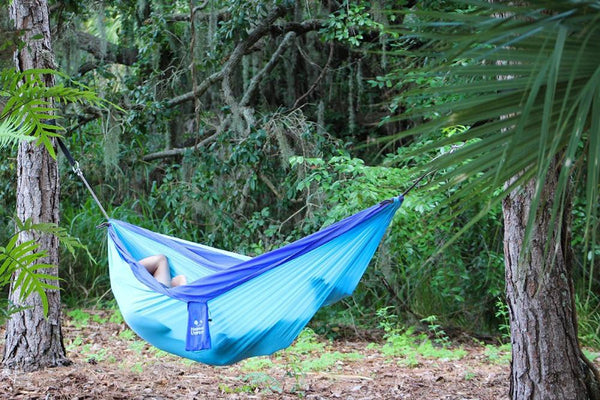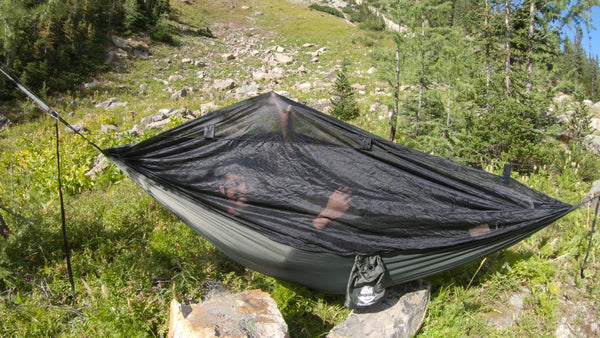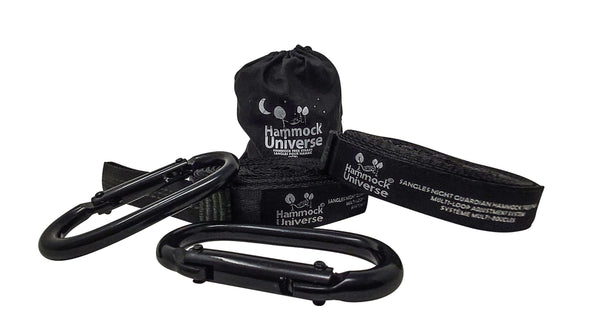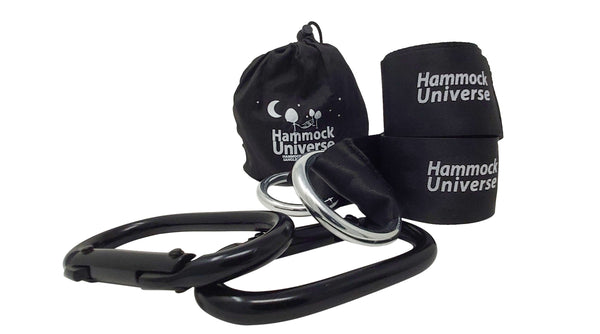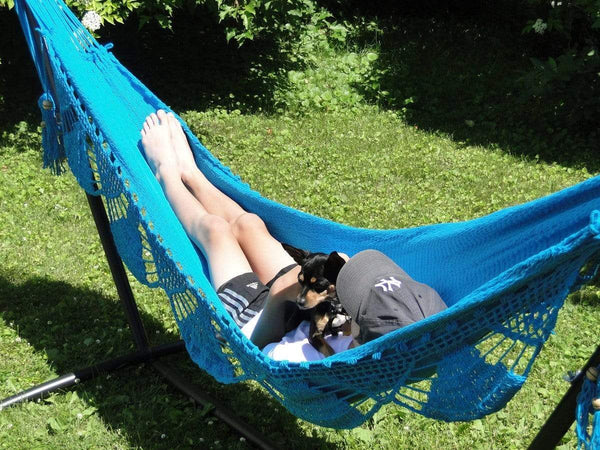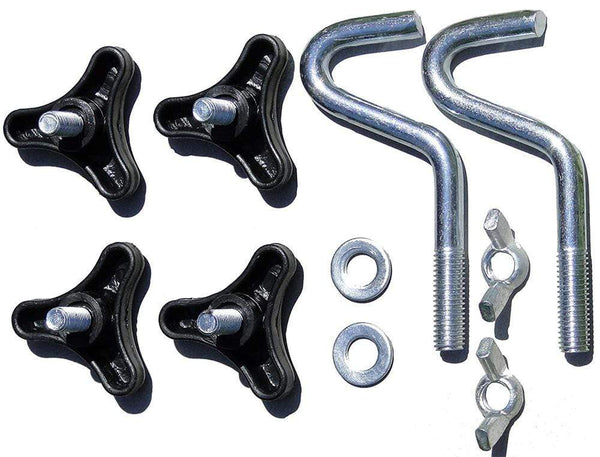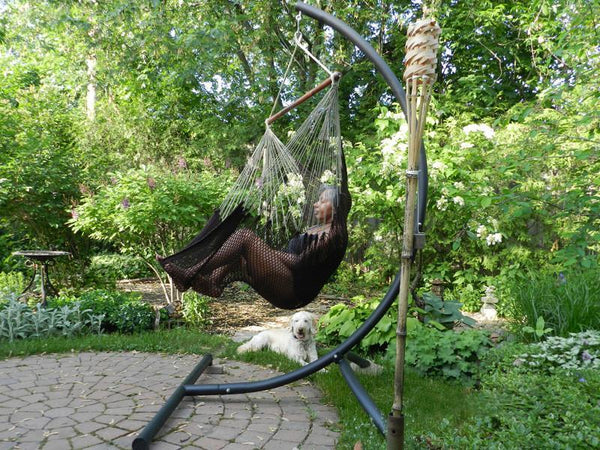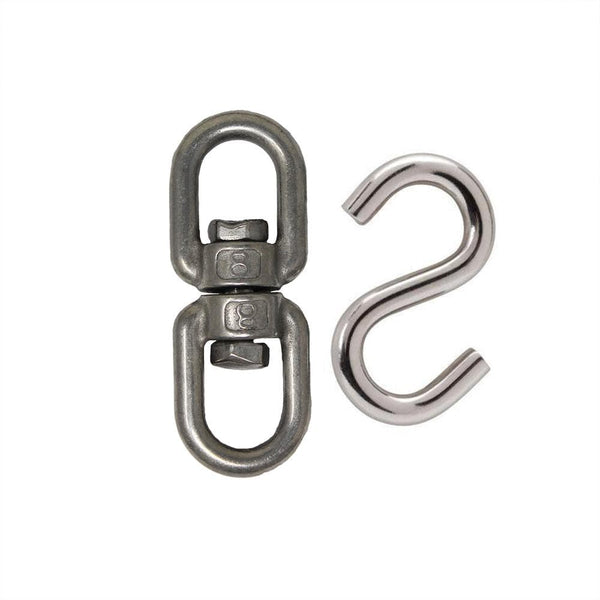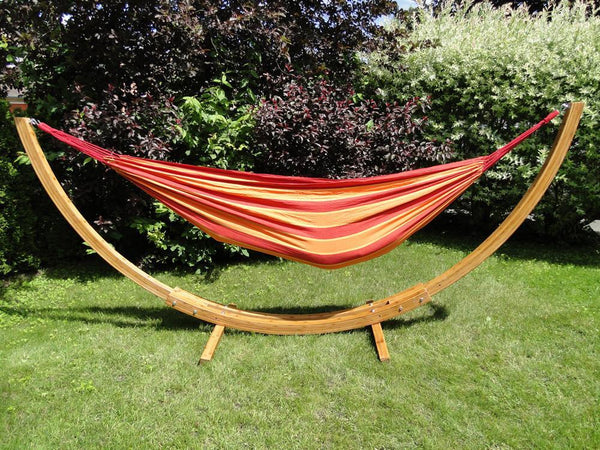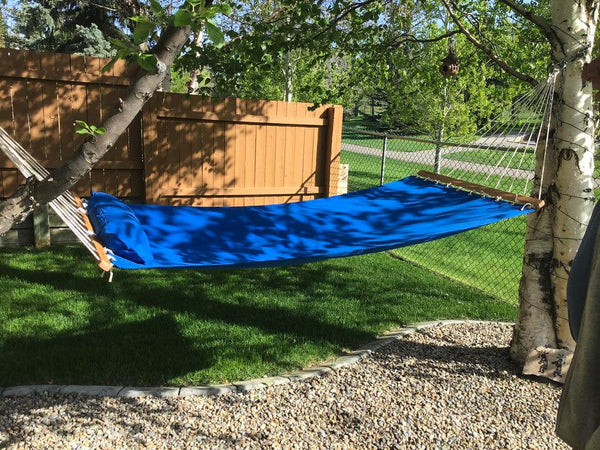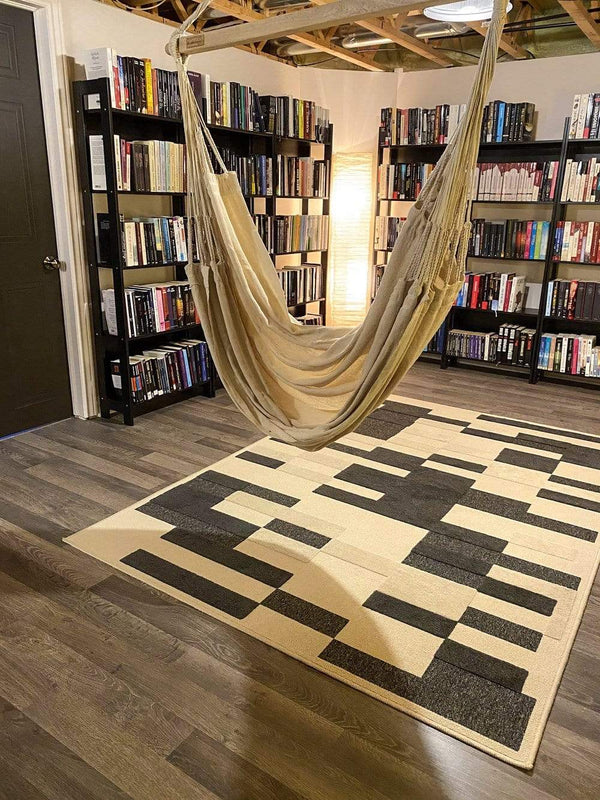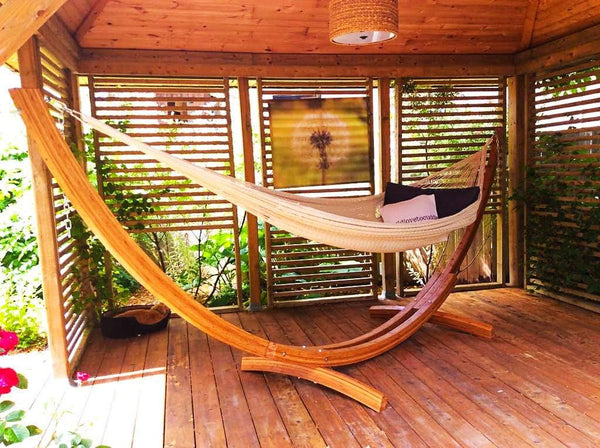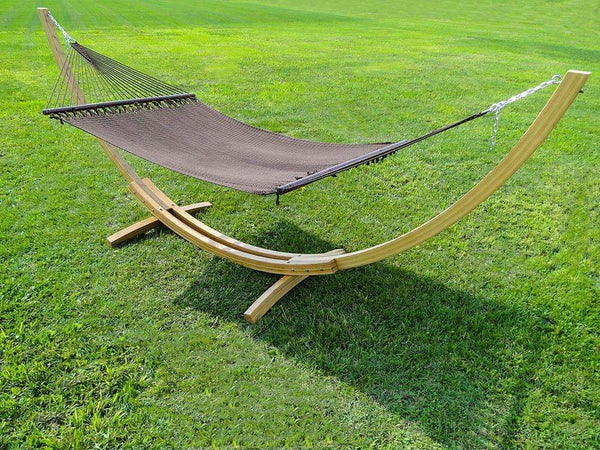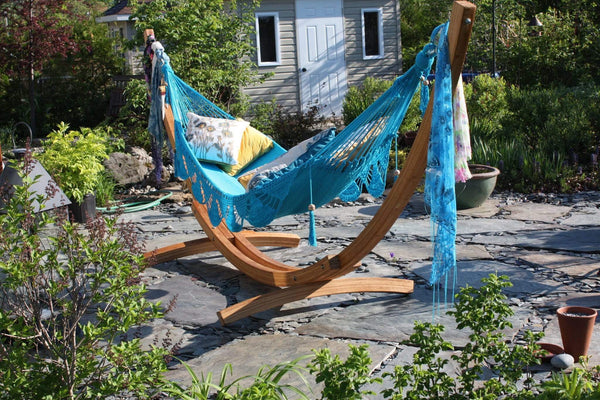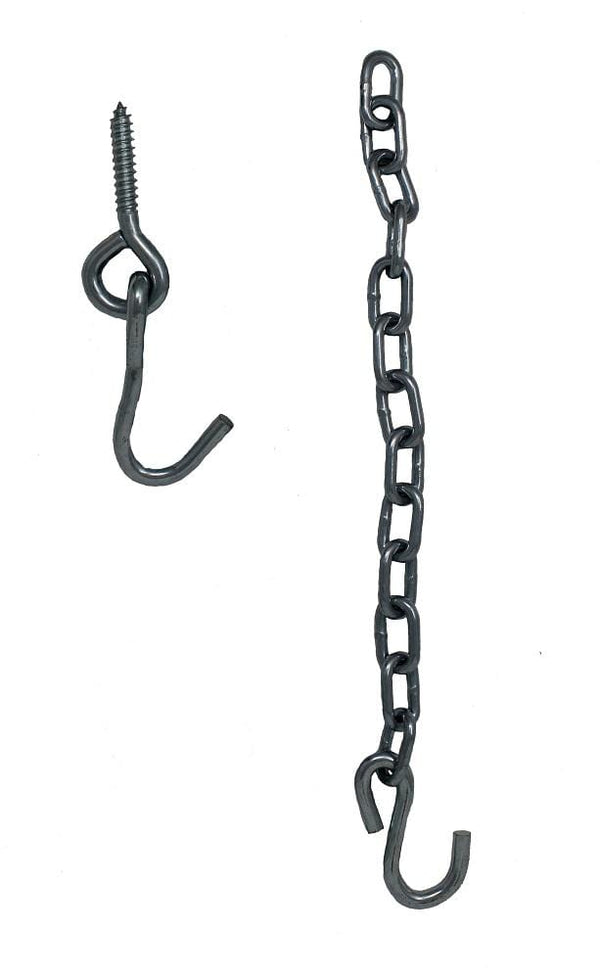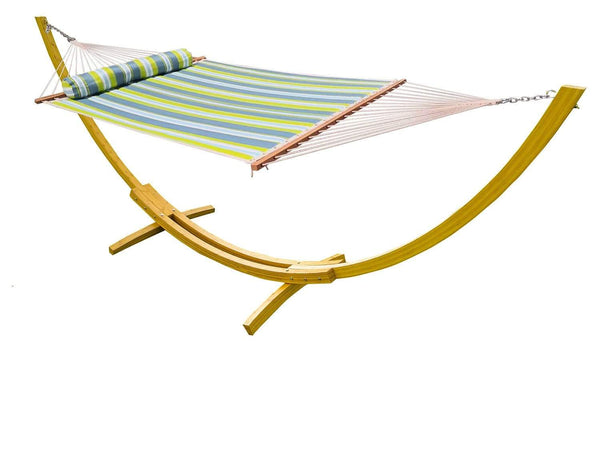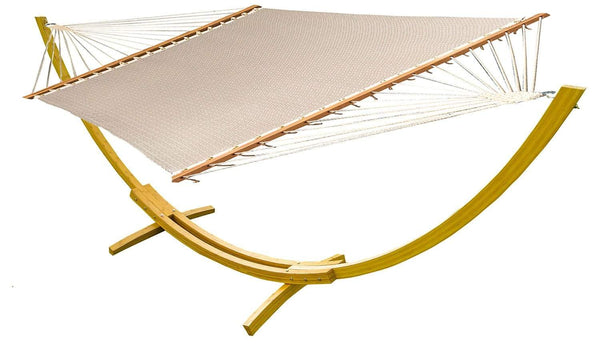FREE SHIPPING on most orders $25+ HAMMOCK BUYING GUIDE
Menu
-
-
Hammocks
-
Hammock Stands
-
Hammocks with Stands
-
Hanging Hammock Chairs
- View all Hammock Chairs
- Brazilian Style Hammock Chairs
- Colombian Hammock Chairs
- Mayan Hammock Chairs
- Mayan Hammock Chairs Deluxe
- Universal Hammock Chair Stand
- U Hammock Chair Stand
- Brazilian Hammock Chair with Universal Chair Stand
- Colombian Hammock Chair with Universal Chair Stand
- Mayan Hammock Chair with Universal Chair Stand
- Mayan Hammock Chair Deluxe with Universal Stand
-
Accessories
- Gift Cards
- Tools and Guides
- Bargain Bin
-
- 1-800-207-4761
- Login

FREE SHIPPING on most orders $25+ HAMMOCK BUYING GUIDE
A Beginner’s Guide to Hammock Camping
October 04, 2021 11 min read
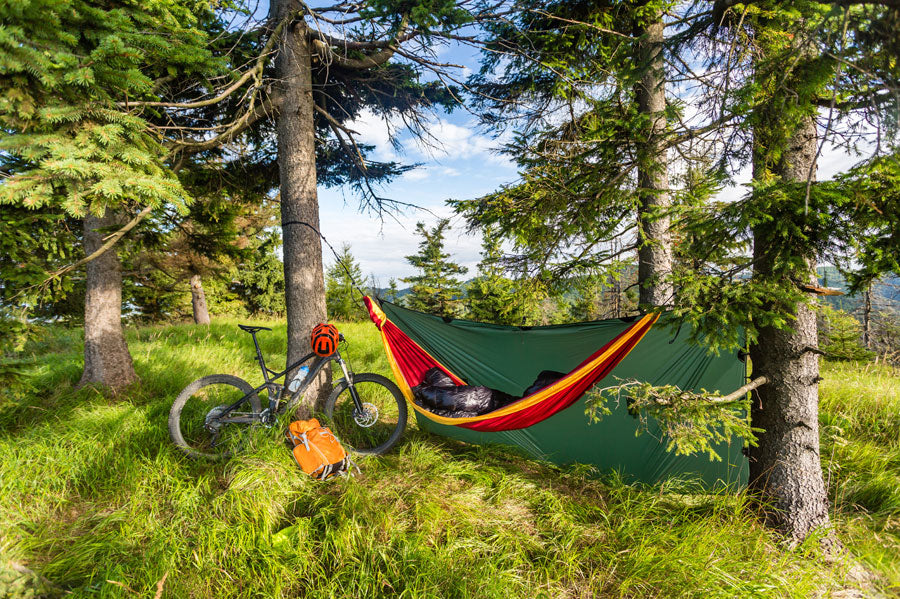
Hammock Vs. Tent Camping – When to Choose Either Option
Nothing quite compares to gently falling asleep as you lie beneath a blanket of twinkling stars.
Except, that is, gently being rocked to sleep while you rest in a hammock under twinkling stars!
If you’re looking for ways to elevate your camping game, there’s literally no better way to do so than with a camping hammock! Not everybody is familiar with what it is like to camp in a hammock. Some people have misconceptions about hammocks. Some of those misconceptions have always been false, but others are false because of recent improvements in hammock technology.
If you have never tried camping in a hammock yourself, you may not realize what you are missing. So what exactly is camping in a hammock like? Read on to learn all about hammock camping and misconceptions about it!
What is Hammock Camping?
Hammock camping is a lot like tent camping. You still have to bring your food and cooking tools. The only real difference is that you will be bringing a hammock instead of camping tents for your sleeping arrangements.
This can make a big difference when it comes to hiking to your camping site. A hammock will generally weigh a lot less than even the best camping tents. It will also take up a lot less room.
Based on that alone, if hammock camping works, it is a far superior option compared to bringing a bulky tent.
On top of that, hammocks are a lot easier to set up than tents. That means that you will also save time and effort setting them up. A great camping hammock can create a better camping experience.
Why It Is Preferable to Camping in a Tent
Of course, that only applies if actually sleeping in the hammock is as good as or better than sleeping in a tent. Many people are under the impression that sleeping in a hammock is uncomfortable or dangerous in some way. Once these misconceptions are corrected, you will be prepared to enjoy a lighter-weight camping trip with a superior sleeping experience!
Common Misconceptions About Hammock Camping (Debunked)
Most people don't have that much experience with hammocks. That is where all the misconceptions about them come from. People are also unfamiliar with the wide range of types of hammocks, some of which are specially designed to avoid the problems that people are concerned about.
It's Cold
Some people overestimate how much a tent protects them from the cold. A tent is certainly better than nothing, but it does not help you that much.
But can a hammock do just as well as or better? The answer is yes! If you are worried about the cold, you can simply get an insulated hammock.
Insulated hammocks are designed to keep your body heat inside you. They are like a second sleeping bag. They're also designed to have high sides that protect you from cold winds.
It's Unsafe
Some people think of hammocks as flimsy things. To be frank, the technology necessary to create sturdy hammocks has been around for a long time. If you want a solid hammock, it is as simple as buying a quality item.
It's Uncomfortable
Most people have not spent a lot of time trying out different kinds of hammocks. If they are unlucky, their limited experience with hammocks might be limited to uncomfortable hammocks.
The truth is that hammocks can be extremely comfortable. There is a reason that they are famously part of relaxed lifestyles and vacations.
The right hammock can be far more comfortable than sleeping on a hard or cold surface like the uneven ground outside.
It Makes it Difficult to Sleep
Between the warmth and comfort that hammocks can provide, they can often help you to get better sleep than you would in a tent on the ground. It can be incredibly soothing to go to sleep while enjoying the beautiful night sky. And they will save you a lot of stress because of how easy they are to transport and set up.
Hammocks Are Complicated to Set Up
Setting up hammocks is actually far simpler than setting up tents. There are far fewer pieces to get in the right place. That also means that there are fewer pieces that can end up breaking and requiring replacement.
Setting up a hammock can be as simple as finding a couple of ropes around a couple of trees and attaching the ropes to holders on the hammock.
Hammocks Have a Limited Weight Capacity
If you are worried about hammock weight capacity, just keep in mind that they create family hammocks. Family hammocks are capable of holding multiple adults and children at the same time.
When you think about that, it should be clear that we know how to make hammocks that can hold plenty of ways.
Tips for Making the Most out of Hammock Camping
If you want to make the most of hammock camping, make sure that you pick the right hammock. If it is going to be cold, you will need an insulated hammock. If it might rain, then you will want a hammock with a protective tarp.
If possible, find a hammock with excellent reviews for comfort. Even trying a hammock can be a great way to prove to yourself how comfortable it is.
What to Bring
Since you’re not packing a tent, you’ll likely have a bit more room for a few key essentials—and then some.
There are some very useful accessories you’ll want to pack to help make your hammock camping experience as fun and enjoyable as possible.
- You can never go wrong with packing a good length of rope. Rope packs small and is easy to carry but has countless uses at a campsite.
- Bring a good mosquito net. It will protect you from bugs and may also add an extra level of privacy.
- Pack a good pillow and blanket or sleeping bag to insulate yourself. Being off the ground means you may get colder than being inside a tent. If the temperature is colder, consider bringing a foam hammock pad or a hammock quilt for extra insulation.
- The ridgeline is a cord that runs between each end of the hammock. Sometimes your hammock will come with this pre-installed, and other hammocks will need one attached. You will need a ridgeline to hang a bug net or tarp.
- Carabiners and suspension straps, also known as tree-hugger straps, are what you’ll use to hang your hammock on the trees.
- A rainfly will protect you from the rain. You can also use a hammock tarp for this. Hammock tarps come in various shapes and sizes. Some are good for fair weather, and others provide more protection from the elements in all four seasons.
- A torch lantern will help you see at night when you want to read, play cards, or need to take a stroll to the outhouse.
Tips for Easy Setup
One of the biggest advantages to camping with a hammock is the quick and easy setup. But there are still some tips for picking the right spot and making sure your bed for the night is set up correctly.
Practice
You may want to try a practice run setting up your hammock at home before you’ve got to get it right while camping. Follow a hammock hanging guide, and consider watching step-by-step how-to videos online to learn how to hang a hammock.
Find a Good Location
When you get to your campsite, do a site check and investigate your area for where the trees are. You’re looking for a good location for your hammock, so watch for shade, sunlight, and clear ground beneath.
You need sturdy trees that will hold your weight. Don’t use saplings or dead trees; these will likely break under any sort of weight, no matter how light you might be.
The ideal tree is thick enough that you can’t completely wrap your hands around the trunk.
You should also take time to check for dead branches further up. If winds pick up, a strong gust could cause one to break off and drop down onto your cozy hammock.
A good setup will need between 10 and 16 feet between trees. Ideally, you want your hammock to hang a foot and a half above the ground. As a rule of thumb, don’t hang your hammock any higher than you’re willing to fall!
At the very most, your hammock can hang four feet above the ground, but that’s pushing it. Aim for somewhere between 18 and 36 inches and you’ll likely be comfortable.
Set Up Early
Make sure to set up before it gets dark! Trying to find all your equipment and tie your knots in the dark is no fun. It’s much more enjoyable to set up nice and early in the daylight so you can relax once you’re tired and the sun goes down.
Suspension
Tree straps for suspension are probably the easiest way to hang a hammock while camping. As a bonus, straps help protect tree bark from damage. When using tree straps, make sure they are at an even height on both trees.
You should also make sure your suspension has enough slack and is at a 30-degree angle from ground level to the anchor (tree strap). This will prevent too much tension that would otherwise make the hammock taught and easy to flip over. This angle will also avoid placing too much force on the suspension from your weight when you get in.
When suspended at a 30-degree angle, your hammock will have a deep sag and a lower center of gravity that will make it easy to get in and out of, and also more comfortable to sleep in.
There are many ways to hang your hammock though, whether with rope, straps, or hanging hardware, so choose the setup that’s right for you.
Tarp Setup
If there’s a chance of rain, you’ll want to set up a hammock tarp as well. Note that the tarp ridgeline should be below the hammock ridgeline suspension.
You don’t want to rest the tarp on your hammock suspension since it will move with the hammock when you move. Instead, this will keep you covered and protected from the rain when you get in and out of your hammock.
You can use a diamond tarp for minimal coverage, or a four-season tarp with door flaps to keep you extra protected from the elements.
The Best Sleeping Position for Hammock Camping
A common mistake people make when setting up their hammock that can lead to an uncomfortable night’s sleep is hanging their hammock too tightly. The tighter your hammock is hung, the straighter and flatter your sleep will be.
Loosen Up
When you get into your hammock, your body weight will pull the hammock tighter and the sides will cocoon around you. A tight hammock will squeeze your shoulders and can even increase the chances of damage to your hammock and the trees it's tied onto.
So the biggest tip for a comfortable sleep in your hammock is to keep it loose! Give your hammock some slack.
Sleep Diagonally
You’re going to end up sleeping on a 30-degree diagonal, not exactly parallel to your hammock, and the extra slack will spread out as you lay down.
This diagonal angle is going to spread out your body weight, avoiding any pressure points. Your head and neck will remain slightly elevated. With the bulk of your weight in the centre of the hammock where the hammock is the tightest, you’ll feel proper support without any worry about tipping.
Once you’ve mastered this diagonal sleep position, you’ll be able to sleep on your back or side comfortably. You can even toss and turn as much as you like as camping hammocks are designed for stability and won’t flip over in the middle of the night.
Sleeping in a hammock provides maximum comfort for your body and back. You can have a better, deeper sleep without sleeping on the hard, rocky ground.
How to Hide Your Food
Remember that rope you packed? You can use it to hoist your food up in a bag in the trees. You want to make sure animals can’t access your food so you’ll want to hide it out of reach. Just make sure it's not hanging in any trees near you.
If you have a car parked nearby, consider storing your food in the car. This will give you added peace of mind knowing your food is well-hidden and secure.
You also have a responsibility to dispose of trash responsibly. Leftover food scraps and packaging can lure unwanted wild visitors to your campsite.
Benefits of Hammock Camping
Once you’ve wrapped your head around trying out hammock camping, you’ll begin to see the many advantages it brings to your outdoor experience.
Lightweight
One of the main advantages to camping with a hammock is that you’ll be able to pack much lighter, which is especially ideal if you’ll be hiking into your campsite or portaging a canoe.
Hammock camping is lighter because you don’t need to pack a tent or a bulky air mattress. All you’ll need are your hammock, bug net, rain fly, and suspension straps, which all pack up nice and small. Hammocks are also a lot cheaper compared to tents, and who doesn’t like saving money on gear!
Easy Setup
Setup and pack-up are a breeze with a hammock. No more tent poles and stakes in the ground, just wrapping tree straps and suspension on trees and hanging your hammock.
With a hammock, you’ll never have to worry again about finding the perfect, flat spot to put up your tent. You won’t need to worry about finding a clearing that’s also clear of bugs or about putting your tent away from potential rain runoff.
All you’ll need is a spot between two trees!
Low Environmental Footprint
If you’re an outdoor enthusiast, you likely enjoy nature and are mindful of your impact on the environment while you’re enjoying the outdoors.
Another upside to hammock camping is that you can have less of a footprint on the campsite because you will sleep suspended in your hammock, instead of compressing the terrain below you under a tent.
Better Sleep & Camping Experience
You’ll also have a better night’s sleep in a hammock. People tend to fall asleep faster in hammocks and have a deeper, more restful sleep. And sleeping in hammocks is ideal for those with sore joints and back pain since it alleviates pressure on your body.
So instead of waking up in a hot tent on a half-deflated air mattress, or on the hard ground, you can wake up feeling refreshed with a cool breeze and stunning view of nature.
This is probably the greatest advantage of all. You’ll get to enjoy the great outdoors and you won’t be confined to four walls of a tent while you’re sleeping.
You can stare up at the stars and wake up to the sunrise while still feeling safe and protected from the elements.
Considerations When Purchasing Your First Hammock
Since sleeping suspended in the air isn’t something everyone is accustomed to, you want to make sure your first hammock is comfortable and that you feel safe sleeping in it.
The ideal camping hammock is lightweight and made from a quick-drying material like nylon. It's strong enough to support your weight and it’s also large enough to cover you comfortably in a cocoon-like wrap when you’re sleeping.
Camping hammocks are also easy to pack and carry. They do not have spreader bars that would add weight and tend to be bulky, taking up too much space in your camping bag.
Spreader-bar hammocks are also not ideal for sleeping in because they tend to be taught and flip over easily. They will not wrap you in a comfortable cocoon and they will not relieve the pressure from your back like comfortable camping hammocks.
Choose a protective rain fly that is at least 8 by 10 feet so it will provide adequate coverage and protection from the elements.
For protection from mosquitoes and other bugs, you’ll want a mosquito net for hammocks. You can also choose an all-in-one mosquito net hammock that combines the comfortable hammock with a net. Hammock camping with mosquito nets is a must for the ultimate comfortable experience.
Finally, don’t forget suspension and tree-hugger straps. These will make hammock setup much easier and be gentler on the trees you’re hanging from. Many hammock kits include all of these parts, but if not, you can easily purchase these accessories from your trusted hammock store.
The Takeaway? Try a Hammock Instead of Tent Camping
We hope that you were able to learn something helpful from this brief article on a few of the biggest differences you should keep in mind when you compare hammock and tent camping. If you have never even tried hammock camping, then you should give it a go at least once to see what it is like for yourself. That single experiment might pay off in the improved quality of camping trips forever after!
To find out more about the benefits of quality hammocks and where you can find great examples, feel free to check out some of our hammocks here!
Safety First!
When using a hammock*, safety is paramount. Please make sure to follow these important guidelines when purchasing, installing and using a hammock
*(includes Hammock, Hammock Chair, Hammock Stand and Hammock Accessories)
Safety First!
When using a hammock*, safety is paramount. Please make sure to follow these important guidelines when purchasing, installing and using a hammock
*(includes Hammock, Hammock Chair, Hammock Stand and Hammock Accessories)
Related Products
Want to relax?
Join for exclusive content and promotions we only give to our email list!
